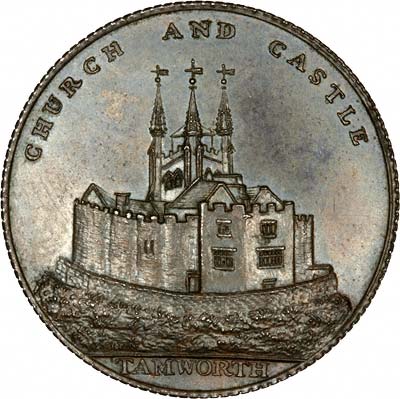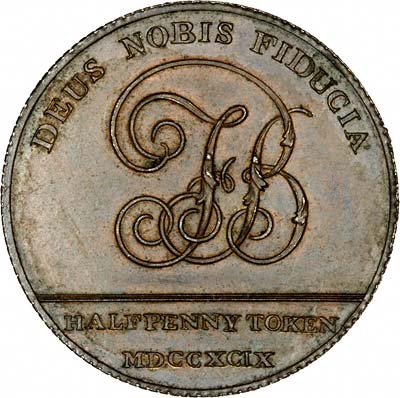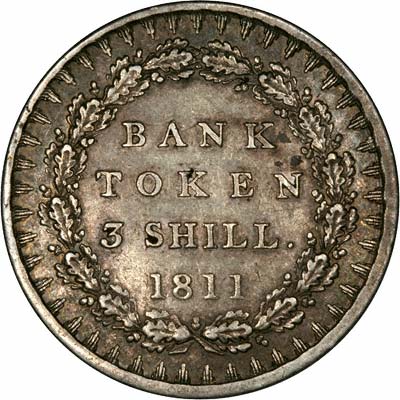| The Very Highest Quality Tokens... |
| British Token Coins |
|

Obverse of 1799 halfpenny token
|

Reverse of 1799 halfpenny token
|

Reverse of 1811 Bank Token |
By the 17th century, inflation had devalued English currency to the point where it was no longer feasible to mint the smallest denominations in silver, although demand amongst the public for coins in the lowest denominations for everyday transactions remained considerable. Despite this however, it was for a long time considered beneath the dignity of the Crown to mint coins for use as currency in base metal. When King James I finally acquiesced to producing copper coins to fulfil the demand for small change in the early part of the 17th Century, he delegated the task to Lord Harrington, who issued copper farthings under licence for a considerable profit. In due course, others were granted similar concessions to supply copper farthings.
These token issues were unpopular with merchants, because of the refusal of those issuing them to redeem them in silver or gold, and they were suppressed by Parliament during the Civil War. However, demand for small change proved to be too much, and merchants began to issue their own tokens from 1648 onwards. These privately-issued copper and brass farthings and half-pennies were generally crudely-struck pieces giving the name of the person issuing them and the phrase 'His Half-Penny/Farthing' along with a description or coat of arms denoting his profession or trade.
This state of affairs continued throughout the Commonwealth Period and the early part of Charles II's reign until 1672, when it was decided that an official issue of farthings and half-pennies in copper and tin would be issued, to replace the unofficial tokens which were in widespread circulation at this time. The superior quality of the new official coinage, and a law which was passed to suppress the old token issues ensured that they disappeared rapidly from circulation.
Unfortunately, despite the success and widespread use of the new official subsidiary regal coinage, the Royal Mint ceased production of the half-penny and farthing in 1775, in spite of a growing shortage of small change. The situation was aggravated by the indifference of the upper and ruling classes for whom the smallest denominations were an irrelevance in their personal transactions. Part of the shortfall was made up by widespread counterfeiting, which although illegal, was generally tolerated by the authorities (or at least, not pursued with particular enthusiasm), partly because it provided a service that was needed, but which they were reluctant or unable to provide. The forgery or clipping of precious metal issues however, was still taken much more seriously by the government, and subject to the most gruesome punishments as it was considered a form of High Treason.**
By the 1780s however, not even the large quantities of counterfeit coins in circulation could supply demand for small change, and their varying quality caused exasperated merchants and others to start issuing their own private tokens once again. These tokens were machine milled, and of vastly superior quality, both to the hand-struck issues of the previous century and to the official circulating currency of the day. Merchants took the opportunity to use these tokens as advertisements for their businesses, as well as a form of personal promotion. These late 18th and early 19th Century tokens are often known as 'Conder' Tokens (after James Conder, an Ipswich drapery owner who in addition to issuing his own tokens, collected and catalogued those of others from all over the country).
Eventually, the Government began to take the shortage of legitimate coinage seriously, and tried to drive out the token and counterfeit issues by employing Matthew Boulton (a private coin manufacturer who had previously been involved in manufacturing tokens under contract) to strike a new series of copper pennies and two-pence pieces with a copper content which was close to its face value in its intrinsic worth (a measure which was intended to deter rampant counterfeiting). Unfortunately, these beautiful coins tended to be hoarded by the public, and this, combined with the fact that they were large and unwieldy, ensured that they were not particularly successful in their intended role. The rising price of copper in subsequent years (during a time of war with France) also meant that it became worthwhile to melt these coins down for their copper content. Further, smaller government contracted issues were minted in 1799, 1806 and 1807, and enjoyed more success, and circulated in sufficient quantites for the rest of George III's reign. Private tokens however, continued to be issued until about 1815.
Throughout the reign of George III, a shortage of silver coinage was also allowed to develop, due to legislation requiring the Royal Mint to buy silver at a fixed rate which was out of tune with the rising market price for the metal, making it unprofitable for the Royal Mint to strike coin to the legally required standard. This situation was made worse by the wars with France, which drained Britain of much of its silver. Countermarked Spanish dollars, valued at four shillings and ninepence (4/9d) made up some of the shortfall, and from 1804, the Bank of England issued its own silver token currency in the form of the Bank of England Dollar (valued at five shillings or, 5/-) along with more oddball denominations such as 3 shilling and 1/6d pieces. Private individuals, banks and institutions also issued their own silver tokens in various denominations, including sixpence, shilling, eighteenpence and two shilling pieces. However, these were widely counterfeited and even these pieces did not keep up with rising silver prices, causing many of them to be melted for bullion.
In 1816, following the conclusion of the Napoleonic Wars, a Coinage Reform Act was passed. The silver coinage was reduced in weight, so that it became a subsidiary issue of the sovereign pound with an intrinsic worth that was still considerable, but not close enough to its face value to encourage melting or exporting of the silver coinage.
The Royal Mint had moved out of the Tower onto new premises on nearby Tower Hill, equipped with new steam-powered mills to facilitate the mass-production of high-quality milled coins to supply Britain's needs for the forseeable future. These devolopments resolved the coin shortage issues that had plagued the nation for over a century, and as the new coins were introduced, the private token issues once again disappeared from general circulation. It was the end of an era for one of the more interesting periods in the history of Britain's numismatic heritage.
*This does not include debased issues, such as those of Henry VIII's later reign, which was more of an attempt to defraud the public to pay for the King's profligate spending than a genuine token issue.
**In 1789, Catherine Murphy became the last person in Britain to be executed by being burned at the stake, which was then the prescribed penalty for females convicted of coining.
*** Britain had been unofficially on the gold standard since 1717, but this was not formally recognised until 1821.
Prices & Availability
All prices on our websites are subject to fluctuation and availability. Please check before ordering.
| Date | Description | Availability | Grade | Price £ | Price $ |
| 1799 | Tamworth Halfpenny Token | Unc | Yes | £395 | $Ask |
| 1811 | Bank Token | VF | Yes | £Ask | $Ask |
Order Form - UK
Order Form - USA
Order Form - EU
Order Form - Rest of World
If you want to find the value of a coin you own, please take a look at our page I've Found An Old Coin, What's It Worth?
There are more answers to be found on our Frequently Asked Coin Questions page.
| ...at the Lowest Possible Price |
|
521 Lytham Road, Blackpool, Lancashire, FY4 1RJ, England. Telephone (44) - (0) 1253 - 343081 & 316238; Fax 408058; E-mail: The URL for our main page is: http://www.24carat.co.uk/index.html Web Design by Snoop |